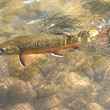As fishermen we all should have a passing knowledge of the core fishing knots. If you’re like me, you grudgingly learned to expand your repertoire of fishing knots after losing a big trout to a hastily-tied surgeon’s knot.
What’s often overlooked, though, is how the knots we use for fishing translate to use in a survival situation. A blood knot might not be the solution for stringing up a hammock, but the theory of binding two pieces of rope together very well could help in a myriad of dire moments.
With that in mind, let’s take a look at some of the most basic knots all of us—fishermen included—need to know.
The Square Knot
Also known as the Reef Knot, the Square is familiar to anyone who attended Cub Scouts. It’s simple to tie, yet it has a ton of potential uses.
The Square Knot is most commonly used to bind two pieces of rope together, especially if you need to strap something down and make sure it stays down. For example, think of building a lean-to but running out of pine branches to use for roof thatching. In that case, ripping up a tarp or emergency blanket and strapping it to the lean-to will prevent water from getting in, and heat from getting out.
The Clove Hitch
This knot gets a lot of love from the climbing community, but it’s considered by many experts to be a must-know knot for survival. It’s quick, easy to tie, and bears a pretty hefty load without sliding. It’s not as strong as a Figure Eight, but as a quick-fix it’s extremely effective.
The Sheet Bend
I’m a bit surprised this knot isn’t used in angling, though I don’t know if it’d work well with tippet. Regardless, the Sheet Bend is uniquely important because it can join together ropes of different thickness, and even ropes made from vastly different materials.
If you find yourself in a survival situation where you have different types of rope (say, fly line and paracord) the Sheet Bend gives you the flexibility to effectively use all of the rope at your disposal.
The Water Knot
Another knot used widely in the climbing community, the Water Knot is a great way to secure webbing belts, or straps together. I’ve used this knot extensively in rappelling and canyoneering and, when tied with high-strain materials, it’s nearly impossible to loosen.
This knot is especially helpful because it can be used with something almost every angler has at their disposal—a wading belt. Whether you need to create a strong weight-bearing knot or have to join together long, flat pieces of material, the Water Knot will get the job done.
The Rolling Hitch
This is similar to tying a tag on an existing piece of leader to more effectively fish nymphs. The Rolling Hitch adds a “leg” to your existing line.
In a survival situation, this knot would work well to quickly adjust your tent, or even help in keeping a pack off the ground at night.
The Timber Hitch
The last knot on the list is perhaps one of the more versatile. The Timber Hitch is used to secure rope to a cylindrical object (like a tree) for either support or hauling.
This knot is especially useful if you need to tie a tarp to a tree in order to create a shelter. In extreme survival situations, you could use it to haul larger logs to a burning pile used to create a smoke signal.
As much as we don’t like to think about it—at least, I don’t—knowing these basic survival knots could save a life at some point. With the amount of time I spend in the backcountry, I never know when something will go wrong. Hell, just a week ago I was in Montana, hiking along a remote stretch of river when I stopped to drink from a spring. I’ve had water from more springs than I can count, but this one? It gave me giardia.
The point is, you should always be prepared for the worst, and the knowledge of these basic knots help you do just that.





























Comments